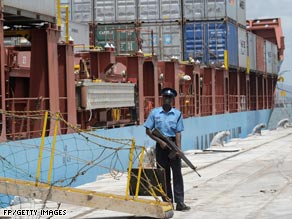(CNN) -- Pirates off the coast of Somalia seized two freighters Tuesday, proving they remain a force to contend with just days after the U.S. Navy dramatically rescued an American captain held by other pirates.
 A Kenyan police officer guards the U.S.-flagged Maersk Alabama at a Mombasa port Sunday.
A Kenyan police officer guards the U.S.-flagged Maersk Alabama at a Mombasa port Sunday.
First, pirates in the Gulf of Aden on Tuesday hijacked the MV Irene EM, a 35,000-ton Greek-owned bulk carrier, according to a NATO spokesman and the European Union's Maritime Security Center.
The crew of the Greek carrier was thought to be unhurt and ships have been warned to stay clear of the area for fear of further attack, the Security Center said.
Later Tuesday, pirates on four skiffs seized the 5,000-ton MV Sea Horse, a Lebanese-owned and Togo-flagged vessel, said Cmdr. Chris Davies of NATO's Maritime Component Command Headquarters in Northwood, England.
Details about the ship and its crew weren't immediately available.
NATO has an ongoing anti-piracy mission off Somalia called Operation Allied Protector. The mission involves four ships covering more than a million square miles, Davies said.
A U.S.-led international naval task force, Combined Task Force-151, is also patrolling in the region.
The two freighters seized Tuesday are the third and fourth vessels hijacked in two days off the Somali coast.
Pirates on Monday hijacked two Egyptian fishing boats carrying a total of between 18 and 24 people, the Egyptian Information Ministry told CNN.
The Egyptian Foreign Ministry is working to end the hijacking, the ministry said.
Egyptian boats are known to use Somali waters illegally for fishing, taking advantage of the lawless state of the country and the lack of enforcement of its maritime boundaries.
Those who have tracked pirate activity in Somalia say it started in the 1980s, when the pirates claimed they were trying to stop the rampant illegal fishing and dumping that continues to this day off the Somali coast.
Piracy accelerated after the fall of the Somali government in the early 1990s and began to flourish after shipping companies started paying ransoms. Those payments started out being in the tens of thousands of dollars and have since climbed into the millions.
Some experts say companies are simply making the problem worse by paying the pirates.
 A Kenyan police officer guards the U.S.-flagged Maersk Alabama at a Mombasa port Sunday.
A Kenyan police officer guards the U.S.-flagged Maersk Alabama at a Mombasa port Sunday.First, pirates in the Gulf of Aden on Tuesday hijacked the MV Irene EM, a 35,000-ton Greek-owned bulk carrier, according to a NATO spokesman and the European Union's Maritime Security Center.
The crew of the Greek carrier was thought to be unhurt and ships have been warned to stay clear of the area for fear of further attack, the Security Center said.
Later Tuesday, pirates on four skiffs seized the 5,000-ton MV Sea Horse, a Lebanese-owned and Togo-flagged vessel, said Cmdr. Chris Davies of NATO's Maritime Component Command Headquarters in Northwood, England.
Details about the ship and its crew weren't immediately available.
NATO has an ongoing anti-piracy mission off Somalia called Operation Allied Protector. The mission involves four ships covering more than a million square miles, Davies said.
A U.S.-led international naval task force, Combined Task Force-151, is also patrolling in the region.
The two freighters seized Tuesday are the third and fourth vessels hijacked in two days off the Somali coast.
Pirates on Monday hijacked two Egyptian fishing boats carrying a total of between 18 and 24 people, the Egyptian Information Ministry told CNN.
The Egyptian Foreign Ministry is working to end the hijacking, the ministry said.
Egyptian boats are known to use Somali waters illegally for fishing, taking advantage of the lawless state of the country and the lack of enforcement of its maritime boundaries.
Those who have tracked pirate activity in Somalia say it started in the 1980s, when the pirates claimed they were trying to stop the rampant illegal fishing and dumping that continues to this day off the Somali coast.
Piracy accelerated after the fall of the Somali government in the early 1990s and began to flourish after shipping companies started paying ransoms. Those payments started out being in the tens of thousands of dollars and have since climbed into the millions.
Some experts say companies are simply making the problem worse by paying the pirates.


Comment